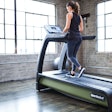Equipment manufacturers are now offering extended warranties, which help protect against unforeseen repair expenses.
One of the largest expenses incurred among new fitness centers involves fitness equipment purchases. Unfortunately, this initial equipment expense is not the only concern with regard to budgetary considerations. Along with the initial purchase price, the total cost of equipment must also be considered in terms of its lifespan. This total cost is a combination of initial purchase price and the sum of maintenance, power requirements (mainly with treadmills), repair and down time for the life of the equipment. Although equipment warranties may protect your investment initially, they are usually much shorter in duration than the average lifespan of the equipment. In addition, because equipment warranties are not standard throughout the industry - and while some may cover wear and tear, others may not - it is difficult to place a set value on the total cost. Fortunately, equipment manufacturers are now offering extended warranties, which help protect against unforeseen repair expenses.
What are extended warranties?
Extended warranties help to protect your equipment investment by extending the warranty period beyond the standard warranty time. Much like standard warranties, these usually begin when the equipment is placed in service, concurrently with the basic warranty, on a deferred basis. This means that a three-year extended warranty on a piece of equipment that has a standard two-year warranty extends only one year beyond the basic warranty. Price varies, depending on the type of equipment and warranty period. Average three-year extended warranties range around $400 for ellipticals, $300 for cycles and climbers, and $675 for treadmills.Benefits
The main benefit of extended warranties involves a guarantee against unforeseen repair costs. To determine the average value of the extended warranty, divide the total cost by the warranty period to determine the yearly cost. In the above example, the treadmill policy of $675 for three years works out to $225 a year as a budget expense for equipment repairs. Facilities not protected by extended warranties may be met with equipment repairs at any given time of $500 to $1,000. These unforeseen repairs can, at any given month, quickly deplete your annual repair budget.What to consider
There are a number of variables to consider when determining whether an extended warranty will benefit your facility: Warranty coverage. Both basic and extended warranties vary among manufacturers, especially involving wear and tear items. Extended warranties that cover these items will protect you from paying out-of-pocket for repairs during the life of the warranty. Type of equipment. Equipment with a high probability of costly repairs benefits more by an extended warranty. Treadmills, due to the large forces created from usage and their many moving parts, have the most costly types of repairs. Given the basic wear and tear items of the deck/belt system and the manufacturers' recommendations of replacement once a year, it is easy to see how a $300 repair, not including labor, will be recuperated within the first two years, based on the price of the extended warranty. Length of equipment in service. The amount of time you plan to keep the equipment in service is another factor to consider. If you plan on selling or upgrading the equipment around the time the warranty expires, there is no need for an extended warranty. Preventive maintenance role. A proper preventive maintenance program is key in prolonging the life of your equipment and keeping it repair-free. Facilities that do not have an extensive preventive maintenance program in place should definitely consider the extended warranties on all their cardiovascular equipment, given the greater risk of repair from neglect.Special circumstances
Be aware of special circumstances, varying among the manufacturers, that may void extended warranties, and are also common with standard warranties:- Make sure the manufacturer's description of equipment use fits your environment, especially in terms of light commercial versus full commercial. For example, you might run into warranty trouble if residential or light commercial equipment is used in a full commercial setting.
- A transfer of ownership of the equipment or shipping outside of the United States or Canada can void some warranties.
- Equipment that has been repaired by a non-certified factory-trained technician or altered in any way is also at risk for losing its warranty. Although extended warranties on fitness equipment may not be beneficial for every facility, they should be considered during the procurement phase. Purchasing quality, name-brand, reliable fitness equipment, protected with extended warranties in combination with a proper preventive maintenance program, will ensure your investment and protect against any unforeseen equipment expense.




































